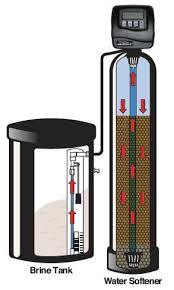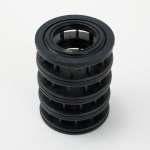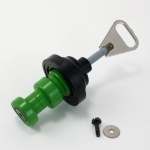We are swimming in a sea of chemicals too numerous to count
by Gene Franks
Since around 1980, when I first started paying attention to such things, the estimated number of different chemicals that find their way into our drinking water supplies keeps going up. This is to be expected. What we should really be concerned about is that our ability to monitor and regulate this onslaught of chemicals has not kept pace.
When the Toxic Substances Control Act (TSCA) became law in 1976 there were estimated to be about 62,000 chemicals in commerce. Under the provisions of the law, these 62,000 chemicals were assumed to be safe unless the newly formed EPA found that they posed an “unreasonable risk.” How many of these has the EPA studied since 1976? About 200. How may has it banned? Five. That’s five. With such oppressive over-regulation, it’s no wonder there are constant cries to reign in the EPA.
Now the estimated total has grown to 85,000 chemicals. Can anyone remember when the EPA last banned a chemical?
The following is excerpted, loosely, from an outstanding article by Peter S. Cartwright. We hope you’ll follow the link and read the full article with the author’s documentation. The italicized text is Mr. Cartwright’s.
Every time water goes down the drain, whether to a sewer, septic system, storm drain or wherever, it carries contaminants with it, which usually end up in someone’s drinking water. Included are unmetabolized pharmaceuticals, chemicals and particles from hand and face washing, bathing, laundry, the toilet—from virtually any and all human activity. The contaminants are in tiny concentrations, but from many thousands of sources and, as our use of pharmaceutical and personal care products (PPCPs) increases, our drinking water is becoming more contaminated.
The number of chemicals that surround us has grown beyond our comprehension. Mr. Cartwright says:
Globally, we now produce more than 85,000 different chemicals, many of which end up in our drinking water. Chemicals are used to manufacture 96 percent of consumer products; the average adult uses nine products per day containing 126 different chemicals. Fertilizers, pesticides, herbicides and antibiotics are all also used in agriculture and animal husbandry operations. Whether from hand washing, bathing, showering, laundry, dishwashing, toilet use—no matter for what purpose we use water, it carries contaminants down the drain. If this water enters a municipal wastewater treatment system, it ultimately ends up in a body of water (lake, river, etc.), which often becomes a source of drinking water. If the wastewater is directed into a septic system, the treated water percolates into the earth, where it usually enters an aquifer or other water supply. Weather events generating runoff from lawn and agricultural surfaces also contribute to this contamination. It’s a fact of life: virtually every time water goes down the drain, it is carrying some contaminants that end up in someone’s drinking water.
Our drug habit, our consumption of “pharmaceuticals,” has gone far past what can be called epidemic proportions. A study in our area, North Texas, a few years ago demonstrated that estrogen spikes in our wastewater mirror the schedule of our universities: when school is in session, estrogen from birth control chemicals peed into the water goes up sharply.
Many of the pharmaceutical products we ingest are not completely metabolized, pass through the body and contribute to [water] contamination. America is the largest pill-popping nation in the world, with 70 percent of us taking one prescription a day, 50 percent taking two and 25 percent five or more per day. Additionally, because people are living longer, more pharmaceuticals are consumed and more end up in the water. Opioid addiction has become a crisis. In the US alone, in 2016, almost 4.5 billion medical prescriptions were issued. Other sources of contaminants include food, toothpaste, artificial sweeteners, caffeine, vitamins, as well as cosmetics, lotion, sunscreen, perfume, deodorant—the list goes on and on.
It would be foolish to assume that such vast chemical exposure poses no health risk to humans, although specific cause/effect relationships between chemicals and health are extremely hard to “prove.” Although Americans’ blood levels of glyphosate (RoundUp) keeps going up, singling out the popular herbicide as a “cause” of any specific human ailment has eluded us.
Mr. Cartwright cites plenty of “anecdotal evidence,” however.
A 2008 Canadian study showed that
In 20 industrialized nations, the birthrate for boys has declined every year for the past 30 years. There has been a 200-percent increase in male sex organ abnormalities over the last 20 years. The average sperm count of North American college students has dropped by over 50 percent in the last 50 years. Up to 85 percent of the sperm in healthy males contains damaged DNA. Over the last 50 years, there has been a 300-percent increase in testicular cancer. For many years, there have been reports of feminization in fish and amphibians, as well as documented genitalia deformities in such diverse animal populations as bears, panthers, sea lions, whales, birds, alligators and others. Between 1999 and 2003, in a population of Chippewa aboriginal peoples in southwestern Ontario, Canada, the birth ratio of boys to girls declined from roughly 50/50 to 33/67.
On chemicals known as endocrine disrupters (EDCs) alone there has been extensive research which clearly reveals the association of exposure to EDCS and human disease. Mr. Cartwright quotes the journal Endocrine Reviews:
“Whether low doses of EDCs influence certain human disorders is no longer conjecture, because epidemiological studies show that environmental exposures to EDCs are associated with human diseases and disabilities.” A follow-up review in 2015 contains the statement: “It simply is not reasonable to assume a chemical is safe until proven otherwise. Clearly, not all chemicals are EDCs, but substantial information needs to be provided before inclusion of a new compound in a food-storage product, a water bottle, health and beauty products or a household product.
A significant hindrance to establishing clear cause/effect relationships with chemicals is that EDCs can have even “transgenerational effects.” It is not easy to trace a person’s ailments back to chemical exposure to his or her grandfather.
Transgenerational effects of EDCs mean that even if a chemical is removed from use, its imprints on the exposed individual’s DNA may persist for generations and possibly forever.
Other common chemicals we are regularly exposed to via drinking water include disinfectants and additives like fluoride.
Chlorine, the common water disinfectant used in municipal drinking water treatment plants can chemically react with some PPCPs and produce DBPs, a class of which trihalomethanes (THMs)contains chemicals known to cause cancer. In recognition of this, US EPA has established a maximum limit for THM compounds, listed in the Safe Drinking Water Act. Many municipalities are adding ammonia to chlorine to produce chloramines, which do not generate dangerous DBPs. The formation of these compounds is an example of the complex chemistry associated with PPCP contamination.
Then there are the “emerging contaminants” known as PFAS.
In addition, fluorine-based chemical contamination of aquifers has become a major issue in many areas. Under the general acronym, PFAS (poly- and perfluoroalkyl substances), they are major components of firefighting foam, Teflon® and Scotchgard® products, coatings on carpeting, clothing, fast-food wrappers and many other consumer products. PFAS exposure has been linked to cancer, obesity, immune system suppression and endocrine system disruption.
Today there are multiple agencies, including the EPA, the CDC, the US Dept. of Health and Human Services, facing the seemingly hopeless task of keeping up with and reporting on the effects of chemicals on the US population. The EPA, for example, publishes a report every two years. The most recent (2017) report included data on 308 chemicals. Let’s see–308 of how many? 85,000. Obviously, chemicals are being put into the environment a lot faster than regulators can regulate them.
Nevertheless, there is, as Mr. Cartwright notes, “a continuous stream of news releases on credible scientific studies that address links between common household chemicals and various health effects.” So many that we can’t keep up with them.
Here are a few:
• In a 2014 study at Columbia University, two chemicals found in such products as lipstick, hairspray, nail polish, dryer sheets and vinyl fabrics (phthalates: suspected EDCs) lowered the IQ of children born to mothers exposed to them.
• A recent Virginia Tech study has found a connection between quaternary ammonium compounds (quats) found in cleaners, laundry detergent, fabric softener, shampoo, conditioner and eye drops, and birth defects in laboratory rodents.
• Again, common household products are implicated in a Washington University in St. Louis study that linked them with ovarian function, resulting in women experiencing menopause two to four years earlier than normal.
It is very important to underscore the fact that, so far, there is no proven link between these trace contaminants and human health. Although many scientific studies are underway, there is lack of conclusive proof that PPCPs are harmful. On the other hand, with so many different chemicals in our drinking water (in this writer’s opinion), it is only a matter of time before a health risk is identified.
Mr. Cartwright’s research points to many unanswered questions involving the relationship of waterborne chemicals with cancer, autism, ADHD, Parkinson’s disease, diabetes, allergies and more. He suggests that the most vulnerable populations are babies, the elderly, pregnant women, and adults with compromised immune systems. It is unclear if the most dangerous chemicals are those that bioaccumulate in the body or those that break down in the body. And he asks what is probably the most persistent and the most difficult questions: Are there combinations of chemicals that present greater risks than individual chemicals and do they react with each other to produce other dangerous compounds?
Reference: Water Conditioning and Purification Magazine.
Pure Water Gazette Fair Use Statement
See also on the Gazette’s site: Emerging contaminants are emerging too fast for regulators.









